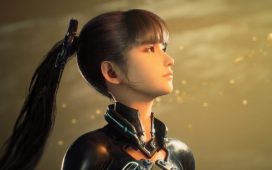Scavengers Reign is a beautiful exploration of a complicated, fascinating, sometimes brutal ecology. Nidus is also a beautiful exploration of a complicated, fascinating, sometimes brutal ecology. Their approaches and styles are different, but the underlying themes share a connection — and an artist. Caleb Wood is an animator and now game developer who worked as a concept artist on Max’s sci-fi show while simultaneously solo-developing his recently released arcade bullet hell game.
Having begun his animation career 15 years ago, Wood decided that he wanted to figure out game development in 2020. Nidus was meant to be something simple that he could use to teach himself programming. “But because I’m able to produce some pretty good art quality,” he says, “I felt like I had to at least try marketing and see what I could accomplish.”
In Nidus, players simultaneously control a flower and a wasp in a symbiotic relationship, as they struggle against all manner of strange insects and critters in their wider ecosystem. Wood draws parallels to the symbiosis in Scavenger’s Reign, where dozens of strange alien creatures live in tenuous, dangerous harmony. In some moments, the humans who crash land there also figure out how to coexist with the nature around them, to varying degrees of success.
But he calls these parallels “autonomous” — he says he wasn’t deliberately planning much about them as he worked on each project. “I definitely gravitate towards natural themes and that sort of thing,” he says. “[But] the only thoughts going in my head [for Nidus] were that I wanna use these creatures and bugs and even the background as a canvas for looping animation.”
Much of Wood’s professional experience is in creating these looping animations. Nidus specifically draws a lineage from some of his earlier short films, like 2015’s TOTEM. Here, animations build up from intricate details, becoming more complex over time, and it’s easy to see it as another example of both the natural themes and the fluid, repetitive style present in Nidus.
During development these kinds of animations became increasingly influential on the game overall. Woods began to create “weaving loops” in specific areas, such as insect shells. “It was a way of putting more and more information into a small piece of animation,” he says. And as these animations became increasingly detailed, he began to realize that overwhelming the player’s attention was ultimately going to become a part of the game’s difficulty.
“Because the game was slowly becoming about splitting the players’ ability to focus, I just decided, ‘Okay, what if I lean into that and make everything absolutely overwhelming and hard to look at?’” Wood says. Combined with the neon colors and simultaneous control of two characters, Nidus is frenetic. (Perhaps more frenetic than intended — Wood says that he might not make design choices like the twin controls again, calling it “not super accessible.”)
By contrast, Scavengers Reign has a much more stripped-back art style. “It’s like you’re playing with geometric shapes whenever you’re designing,” says Wood of his work on the creature designs. It was “refreshing,” he says, to switch back and forth between the two projects.
Both animation for TV and games felt similar in that he was trying to create solutions to restrictions. On Scavengers, Wood would get requests from the show’s co-creator and art director Charles Huettner to fill a certain narrative function. In Nidus, the art would need to fit in with the game. “Whenever I’d work on creature designs for the show, it would clear my mind to go back into the mess of Nidus,” Wood says, and vice versa to get back to the reduced designs of Scavengers Reign.
He also says that working on a team for Scavengers meant things were simpler for him personally. “You’re just focusing on your small part that is going to serve a larger purpose,” he says. Working solo, making one design choice also meant dealing with all the knock-on effects. Changing an enemy’s weak spot, for example, isn’t just editing the art, but also everything further down the line of dominos — code, game design, and so on. “That spirals out of control real quick,” says Wood.
Wood isn’t sure exactly what’s next, but he would like to keep making games — in a team, if possible. Although he says Nidus was useful to give himself a rounded understanding of all the different parts of game development, he says it would be “amazing” to get a dedicated programmer. But whatever his next project ends up being, given his existing body of work, it’s fair to say there’s a good chance it’ll involve strange creatures and the ways they coexist.












